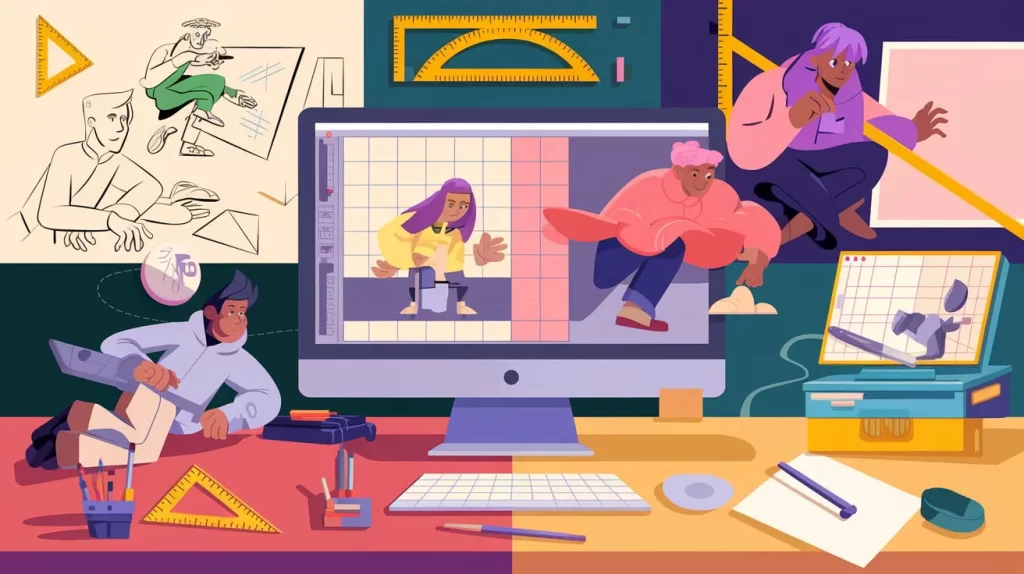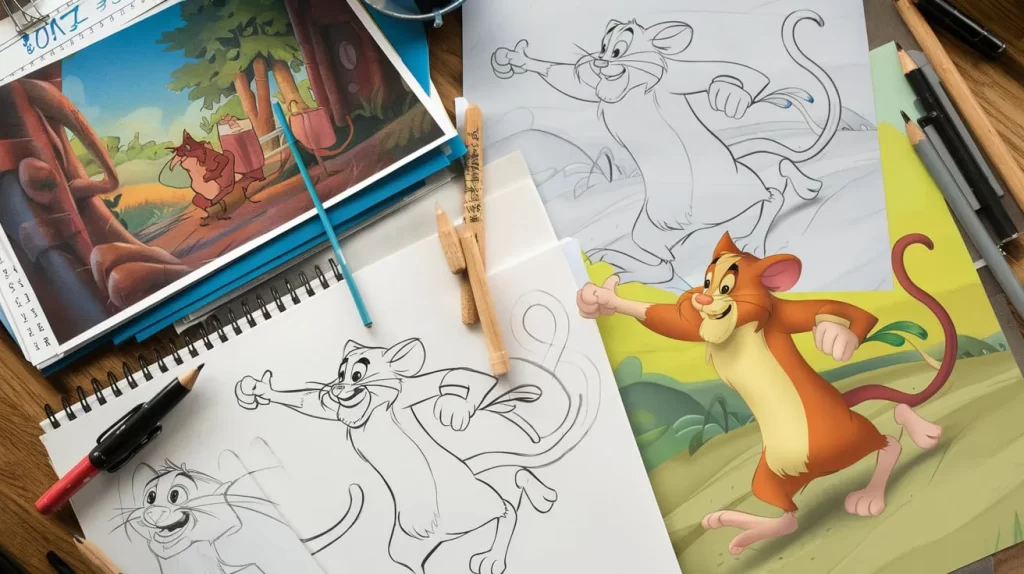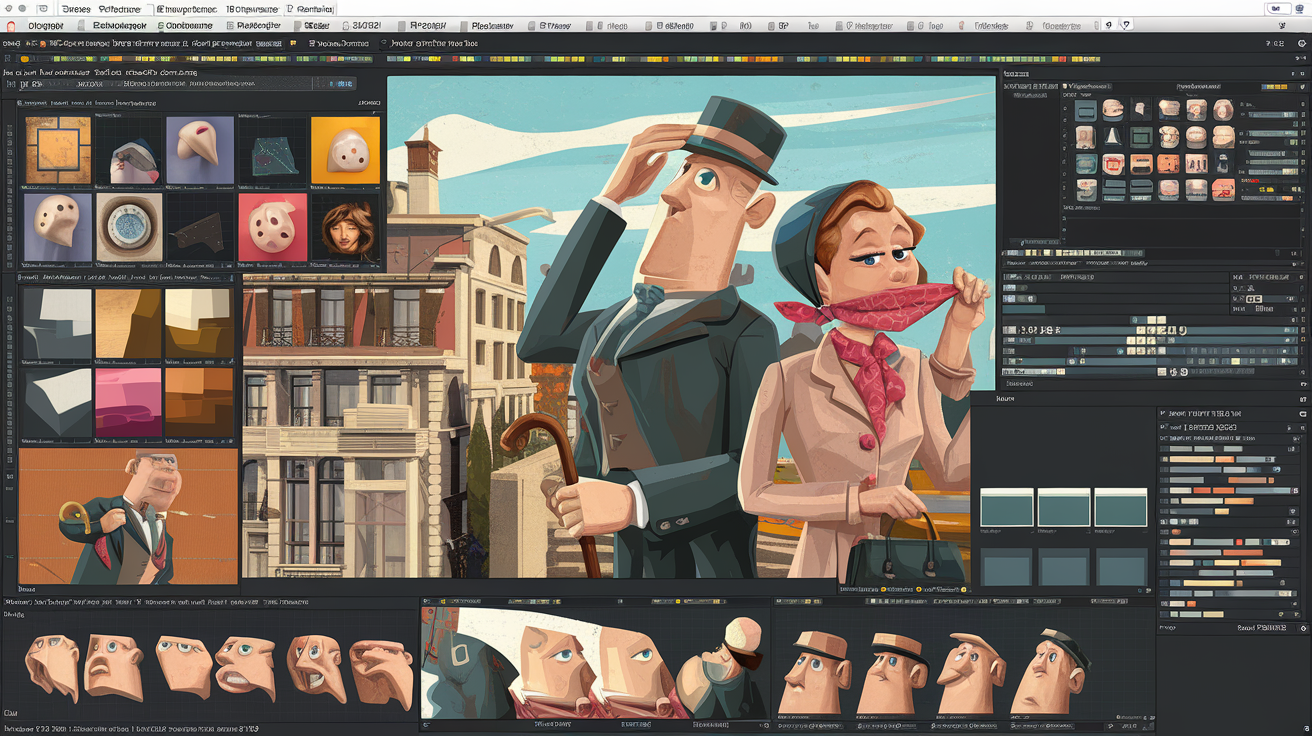Animation has captivated audiences for decades, bringing stories and ideas to life in visually stunning ways. When we think of animation, many of us envision vibrant, moving images—often in 2D. But what exactly is 2D animation, and how does it differ from other forms of animation, like 3D? We’ll break down everything you need to know about 2D animation, from its definition to how it works, the different types of animation, and how to get started as a beginner. Whether you’re a budding animator or simply curious about the world of animation, this post will provide a comprehensive and beginner-friendly overview.

Understanding 2D Animation
What is 2D Animation?
2D animation refers to the creation of moving images in a two-dimensional space. It’s a process in which characters, objects, and scenes are designed and animated in two dimensions: height and width. Unlike 3D animation, which involves depth and volume, 2D animation focuses on the flat appearance of characters and objects, moving across a two-dimensional plane.
2D animation has been around for decades and remains a crucial element of the entertainment industry, from classic hand-drawn cartoons to modern digital animations seen in films, television, and even online platforms like YouTube.
Related Posts:
- What is 2D Animation? A Beginner’s Guide
- Exploring 2D Animation Careers: Turn Passion into Profession
- Advanced Techniques in 2D Animation
Key Differences Between 2D and 3D Animation
While both 2D and 3D animation are used to create moving images, there are key differences between the two:
- Dimensionality: 2D animation is flat, while 3D animation creates depth and volume, making characters and environments look more lifelike.
- Process: 2D animation often involves drawing frames manually or digitally, whereas 3D animation uses modeling software to create objects that exist in three dimensions, allowing for more dynamic movement.
- Complexity: 3D animation can be more complex, requiring additional technical skills to create and animate 3D models. 2D animation, especially traditional hand-drawn methods, can also be time-consuming but doesn’t require the intricate 3D modeling and rendering.
While both have their unique characteristics, 2D animation continues to hold its ground in the world of animation for its simplicity, charm, and artistic flexibility.
How 2D Animation Works
At its core, 2D animation involves creating a sequence of images, or frames, that are displayed rapidly in succession. This rapid display creates the illusion of movement, similar to how flipbooks work. The key steps in creating a 2D animation typically include:
- Storyboarding: Planning out the animation with sketches or rough drafts to map the action and key scenes.
- Keyframing: Drawing the essential frames that show the start and end points of an action.
- In-betweening: Filling in the frames between the keyframes to ensure smooth transitions.
- Finalizing and Rendering: Adding color, backgrounds, and final touches before compiling the frames into the final video.
Though this process can seem straightforward, each of these steps requires careful attention to detail to ensure that the animation is fluid, expressive, and visually appealing.

Different Types of 2D Animation
2D animation isn’t a one-size-fits-all art form. There are different styles and techniques, each with its unique characteristics and uses. Below, we’ll break down the four major types of 2D animation.
Related Posts:
- The Process of Creating 2D Animation: From Concept to Completion
- Best 2D Animation Studios & Agencies
- What is 2D Animation? A Beginner’s Guide
Traditional 2D Animation – The Hand-Drawn Approach
Before digital tools became widespread, traditional 2D animation was entirely hand-drawn. This process involves creating each frame of the animation by hand-drawing or painting the images on paper or transparent sheets (called cells).
This method can be labor-intensive, but it offers a unique, organic feel to the animation. Famous examples of traditional 2D animation include Disney classics like The Lion King and Snow White and the Seven Dwarfs. The meticulous care required for each frame has given traditional animation its distinct charm and appeal.
Digital 2D Animation – Computer-Generated Animations
With the rise of technology, digital 2D animation has become the industry standard. Digital tools like Adobe Animate, Toon Boom, and TVPaint allow animators to create digital versions of traditional 2D animation without the need for hand-drawing every single frame.
Digital animation streamlines the process by providing tools for easier editing, faster production, and greater flexibility. It’s commonly used for television shows, YouTube videos, and animated films.
Vector-Based Animation – The Flexibility of Scalable Assets
Vector-based animation uses mathematical equations to create images that are defined by points, lines, and curves rather than pixels. This allows the artwork to be infinitely scalable without losing quality, making it an excellent option for animations that need to be resized frequently, such as logos, icons, or motion graphics.
Software like Adobe Animate and Synfig Studio are often used to create vector-based animations. The clean, crisp lines of vector art also give the animation a modern, minimalist aesthetic.
Puppet Animation – Using Rigged Elements for Movement
Puppet animation involves creating characters or elements that are “rigged” or pre-constructed for movement. Think of it like marionette puppets that are manipulated with strings, but in this case, the “strings” are digital rigs.
With puppet animation, animators can create complex movements with fewer frames by manipulating pre-rigged assets. This technique is particularly useful for creating animations with repetitive movements or characters that need to interact with each other in a limited space. Adobe Character Animator is an example of software used for puppet animation.
How to Get Started with 2D Animation
If you’re a beginner eager to dive into the world of 2D animation, getting started might feel overwhelming. But with the right tools, mindset, and resources, you can begin creating stunning animations in no time. Below are the essential first steps to get you started:
Basic Tools You Need to Get Started
To create 2D animations, you’ll need the right software and tools. While professional-grade animation software can be expensive, there are plenty of beginner-friendly options available:
- Adobe Animate: A versatile program for creating vector-based 2D animations.
- Toon Boom Harmony: Used by industry professionals, this software is ideal for both traditional and digital animation.
- Krita: A free and open-source painting program that offers tools for animation.
- OpenToonz: Another free, open-source option, often used by studios and independent animators alike.
In addition to software, you’ll need a drawing tablet for precise control over your artwork and animation. Some beginner-friendly options include the Wacom Intuos or XP-Pen Deco.
Introduction to Storyboarding and Keyframes
Before you jump into animating, it’s important to plan your animation with storyboarding. Storyboards are essentially visual outlines of your animation’s scenes, showing the progression of actions and camera angles. They provide a blueprint for animators to follow and help ensure that the animation flows smoothly.
Keyframes are another critical concept in 2D animation. These are the most important frames in an animation, showing the start and end points of a movement or action. Between these keyframes, you’ll add in-betweens, which fill in the gaps and make the motion fluid.
Recommended Resources for Beginners
Countless online resources can help you improve your animation skills, including free tutorials, online courses, and animation communities. Some popular resources include:
- Animation Mentor: Offers comprehensive online animation courses.
- Schoolism: Provides video courses by industry professionals.
- YouTube Channels: Channels like Alan Becker and The Animation Guild offer free tutorials for beginners.
By utilizing these resources, you can develop the technical skills and creative vision needed to create high-quality 2D animations.
FAQs
What is the best software for beginners to learn 2D animation?
Some of the best beginner-friendly software includes Krita, Toon Boom Harmony Essentials, and Adobe Animate. These tools provide a balance of ease-of-use and advanced features to help you start creating professional-looking animations.
How long does it take to learn 2D animation?
The time it takes to learn 2D animation varies depending on your dedication and the complexity of the animations you wish to create. Beginners can expect to learn the basics in a few months, while mastering advanced techniques can take several years.
Do I need drawing skills to create 2D animation?
Basic drawing skills can be helpful, but they aren’t essential. Many digital animation tools allow you to work with shapes, vectors, and assets rather than freehand drawing. That said, strong drawing skills can enhance the quality of your work.
What are the most common mistakes beginners make in 2D animation?
Some common mistakes include: not planning the animation properly (skipping the storyboard), not using enough keyframes, and failing to make the animation flow smoothly with proper timing.
Key Takeaways
2D animation is a dynamic and creative field that allows artists to bring their ideas to life in a two-dimensional space. Whether you’re interested in traditional hand-drawn techniques or modern digital approaches, there are a variety of styles and tools to explore. Understanding the basics of how 2D animation works, its various types, and how to get started with essential tools and techniques will help you begin your journey as an animator.
- 2D animation involves creating moving images in two dimensions, with no depth or volume.
- Traditional 2D is hand-drawn, while digital 2D uses modern tools for faster, more flexible animation.
- Key types of 2D animation include traditional, digital, vector-based, and puppet animation.
- To get started, you need the right software and hardware, such as drawing tablets and animation software.
